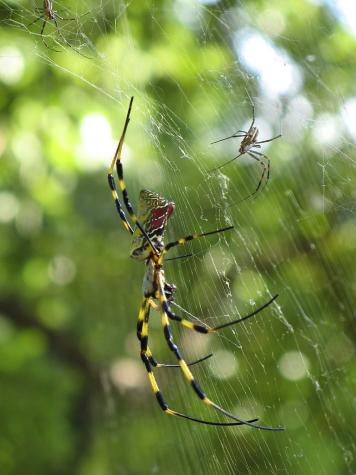COLUMBIA, Mo. – Flying monkeys, creepy crawlies and monsters under the bed need to make way for the Joro spider.
But Missouri arachnophobes can rest easy for a bit, says University of Missouri Extension urban entomologist Emily Althoff. Introduced to the United States a decade ago, the Joro spider is a slow traveler.
To date, the closest sighting of this colorful orb weaver was in central Tennessee. You can follow its travels through Joro Watch, a website developed by the Southern Integrated Pest Management Center.
“Although these spiders are not currently in Missouri, work conducted by David Coyle and his team has shown that the Joro spider is likely to expand northward, eventually making its way to the Midwest,” says Althoff. “The Midwest is highly suitable habitat for it due to our temperature and precipitation.”
While their appearance can be intimidating, Joro spiders don’t typically bite humans and are relatively docile. Their small fangs and weak venom cause damage similar to that of a bee sting.
The female Joro is a beautiful spider with interesting behavior, says Althoff. The abdomen of this Asia native is about an inch long with brilliant blue-green bands on its back and red markings on its belly. Its 4-inch willowy legs are long and black, often with yellow bands. Adult males, by contrast, are only about a quarter-inch long and brown.
Young Joro spiders move through the air by “ballooning.” The spiderling raises its abdomen and releases a strand of silk that can catch a breeze. Ballooning spiderlings can travel tens to hundreds of miles, especially if carried by strong winds and storms.
They spin impressive 10-foot-wide webs suspended between objects such as trees or fence posts.
Althoff says it’s sometimes easier to explain what Joro spiders are not, because they are often confused with common lookalikes found in Missouri:
The golden silk orb weaver was previously the only species of Trochonephila (the Joro spider genus) in the U.S. The simplest way to distinguish between these and their invasive relatives is the exaggerated “brushes” on the legs of the golden silk orb weaver.
The black and yellow garden spider fashions a distinctive “zipper” on its web. It is a frequent visitor of homes and gardens, where it helps control insect pests.
The banded garden spider also helps control insect pests. It is smaller than the black and yellow garden spider and has a pointy abdomen.
Photo
Joro spiders
Female Joro spider with the much smaller male. Photo by Micha L. Rieser, via Wikimedia Commons. Attribution required.
